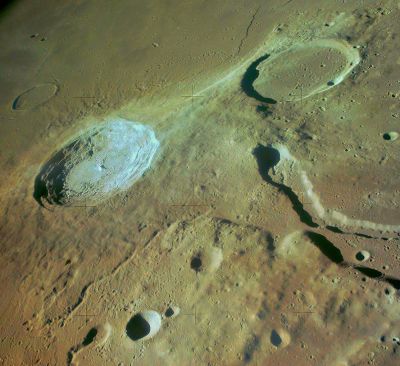Cobra Head
Contents
[hide]Cobra Head
(informal name; part of Schröter's Valley)|
Lat: 24.5°N, Long: 49.2°W, Diameter: 13 km, Depth: km, Rukl: 18 |

Apollo 15 AS15-88-12002. The Cobra Head is the broad, partly shadowed area at the top of Schröter's Valley; south up.
Images
LPOD Photo Gallery images Lunar Orbiter Images Kaguya HDTV
Maps
(LAC zone 39A4) LAC map Geologic map
Description
The elliptical depression at the head of Schröter's Valley on the Aristarchus Plateau. Scientists think that the Cobra Head depression was the main vent for magma that rose up from the lunar mantle to create the Valley and flood northern Oceanus Procellarum with lava. The Cobra Head has been the locus of various reports of change on the Moon. In the early 1900s WH Pickering believed that a white vapor frequently issued from the Cobra Head, and in 1963 two observers at Lowell Observatory described red glows there and nearby in Schröter's Valley and Aristarchus. There is a bright area around the Cobra Head which is more or less visible according to the angle of solar lumination. The Flagstaff observations were made when the Moon was low and seeing was not stable; both sets of reports are often regarded as revealing more about Earthly observers than changes on the Moon. See Epic Moon for nice accounts of these observations. - tychocrater Aug 19, 2007
Description: Elger
Additional Information
Nomenclature
The curving Schröter's Valley reminds some observers of a snake, and the crater-like enlargement at its south end has been called the Cobra Head. According to The Moon (p 262) of Wilkins and Moore the name was given by W.H. Steavenson, prior to 1949 when it appeared in an observing report by F.H. Thornton (footnote 11, p 260 of Epic Moon). - tychocrater Aug 19, 2007
LPOD Articles
Bibliography
- APOLLO OVER THE MOON; A VIEW FROM ORBIT, Chapter 6: Rimae (Part 1: Sinuous Rimae), Figure 188.
- Sky and Telescope, December 1963, pages 316-317; A Recent Observation of Lunar Color Phenomena (James A. Greenacre, Edward Barr).